MOTOROiD : Λ
In 2025, a new lineage of MOTOROiD begins.
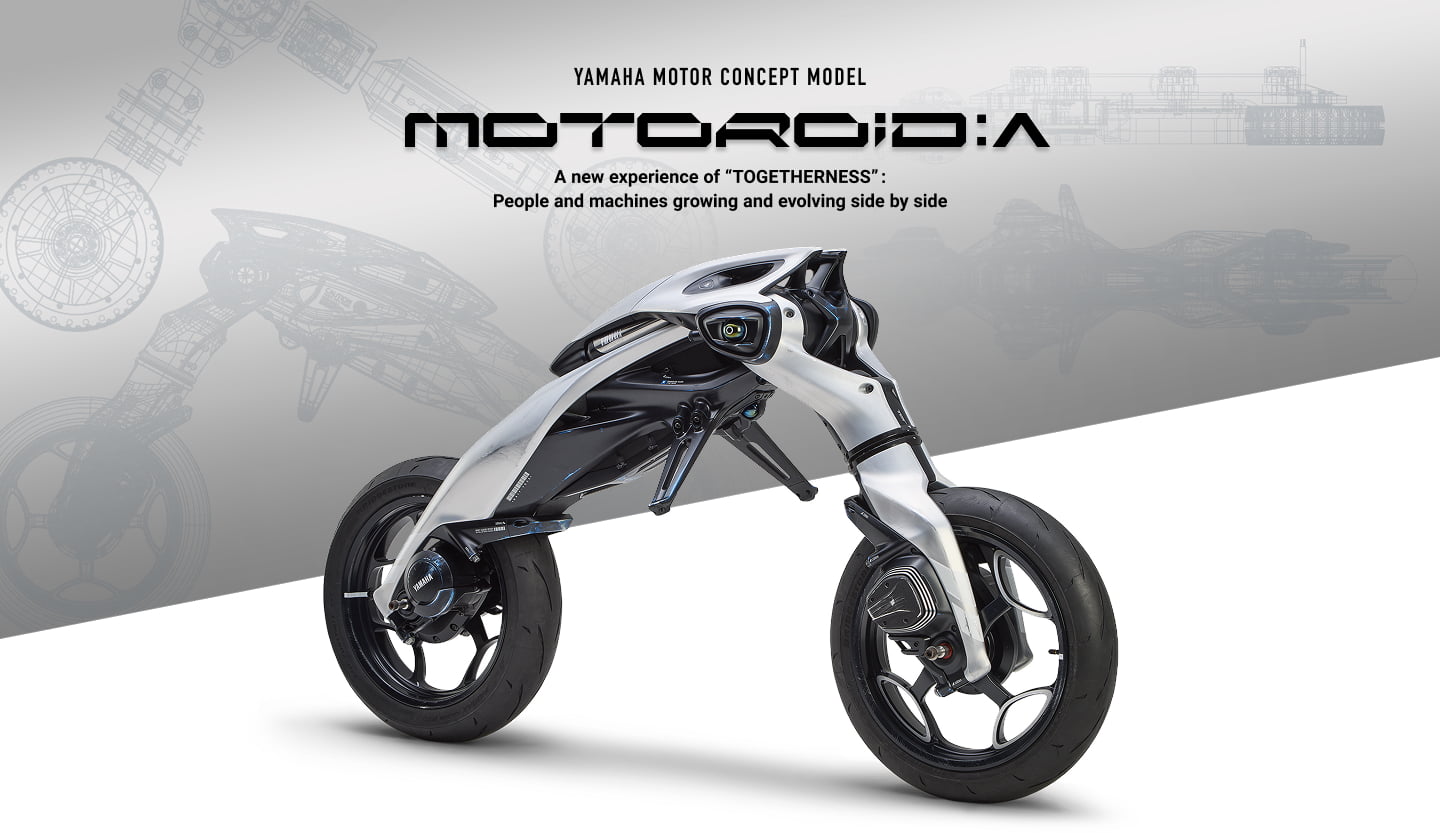

The return of a proof-of-concept machine
that has shattered conventions
“What in the world is this?!”
You can be sure that’s a common thought running through people’s heads as they lay eyes on one of the centerpieces of the Yamaha Motor booth. It has two wheels—front and rear—but no handlebars and no seat. What do you even call a machine like this? A robot? Mobility? A motorcycle?
However you want to categorize it, it has a name: MOTOROiD:Λ (Lambda).
Following the MOTOROiD and MOTOROiD 2, which both challenged popular conceptions of the relationship between people and machines, this new proof-of-concept model once again stands before us—a singular creation with a compellingly curious form, endowed with intelligence that might even surpass our own.

A trial-and-error process
that goes beyond human capabilities
The earlier MOTOROiD and MOTOROiD 2 shared a defining feature: a battery positioned between the front and rear wheels. Not only did the battery contribute to the machines’ look, but it also served as a counterweight for self-balancing, controlled by a technology called AMCES. In the MOTOROiD:Λ, however, AMCES gives way to the key technologies of reinforcement learning and Sim2Real. With this pair working in tandem, AI runs countless high-speed simulations in a virtual environment, learns from each trial, and applies the results in the real world. Reinforcement learning, an extensive AI-based trial-and-error process, has enabled the machine to gradually master every one of its movements, from standing up and going straight to handling uneven surfaces. In visualizations of the system learning in its virtual training environment, you can see thousands of digital MOTOROiDs, each with different combinations of parameters like body posture, surface condition, and tire grip, repeating an astronomical number of trials that would never be feasible in real life.
Inspiring each other—and evolving together
With its advanced intelligence and control capabilities honed through reinforcement learning, MOTOROiD:Λ can stand and move on its own. And every time it makes a run, the data goes back into its system, allowing the machine to grow through real-world experience. During development, the team was surprised to find that the AI sometimes solved set tasks in ways they hadn’t anticipated. But we humans do the same thing; we improve through our own “runs,” deriving joy from progress itself. So when an experienced, intelligent person engages with the experienced, intelligent machine that MOTOROiD:Λ represents, what kind of relationship might emerge? For Yamaha, the answer is the idea of “TOGETHERNESS.” If the key idea behind the earlier MOTOROiD and MOTOROiD 2 was “ONENESS,” an expression of rider and machine becoming physically one and the same, then “TOGETHERNESS” represents Jin-Ki Kanno as more of a relational kind of unity.
When people and machine meet each other on even ground, both growing independently, they can challenge each other and build a positive relationship—a healthy rivalry, in a way—through mutual evolution.
To explore that vision of a new relationship between people and machines in the future, we designed MOTOROiD:Λ around the concept of “mutual inspiration for growth.”


An organic form,
forged through technological optimization
If the MOTOROiD:Λ’s brain is its neural network,*1 shaped through reinforcement learning, then the body acting on the brain’s commands is the “Multi Axis Body” with two movable axes. By coordinating the axes’ motors with the drive motors on the front and rear wheels, the machine moves with a lifelike presence—muscles moving bones, a veritable vertebrate in action. The front and rear arms extend from the central pivot point, housing motors, CPUs, and batteries but still managing to strike a slim profile. The arms form smooth arcs linking the two wheels to create the organic silhouette, almost like an exoskeleton, that gives MOTOROiD:Λ its unique aesthetic identity. When the pivot opens to its full 180 degrees, the wheelbase reaches maximum length, and the arms form an S-shaped curve with the two wheels at both ends. Evoking the supple limbs of a living creature, the machine looks ready to adapt to any environment.

Designed for a lasting, better relationship
between people and machines
Though the MOTOROiD:Λ wasn’t designed for people to ride, the design foregrounds the idea of people and machines coexisting in every last element of the form. The rounded edges pervading the machine’s contours were the product of two priorities: people’s safety, first of all, and an effort to enhance durability so that, if the machine were to fall over, there would be minimal scattering of part fragments and damage to the body.
On MOTOROiD:Λ, you won’t find any handlebars, seat, footrests, or even the haptic devices that past models used. There’s generation-to-generation continuity, of course. The new machine inherits MOTOROiD 2’s use of infographic lighting, for example, which serves to express person-machine communication in a visual way. But that technology has undergone its share of updates, as well. New colors, contrasts, and flash speeds make it easy to intuitively read the machine’s presence and movements—forward, backward, and more—even from a distance.
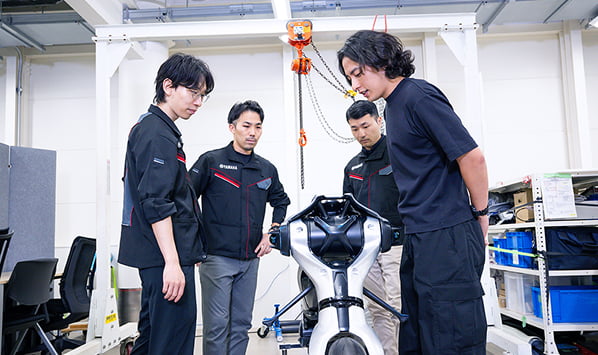

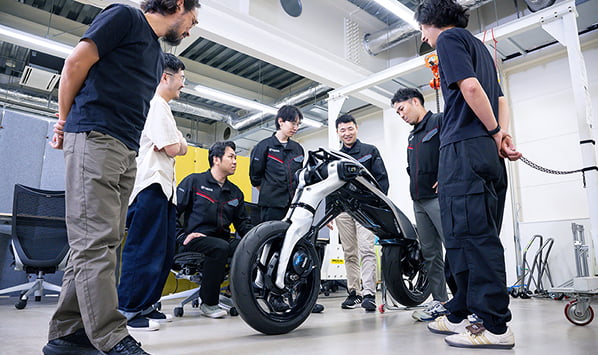

Another striking visual approach is evident in the product design’s CMFG framework (Color, Materials, Finish, Graphics), which Yamaha extended by adding one more element—T, for Time. The addition captures a positive take on the wear and damage a machine takes on over time, framing those changes as a record of growth, not flaws. If you look closely at the machine, you’ll see scores of scratches and scuffs across the body—physical representations of marks left by the countless trials, falls, and impacts it endured as it grew through virtual training. On MOTOROiD:Λ’s black-painted exterior surfaces, you’ll also notice patches where the coating has worn away, revealing a layer of blue underneath. Inspired by “Negoro-nuri,” a Japanese lacquerware technique, the finish uses a matte black coat over a blue alumite-treated layer so that as the machine “ages” through use, the blue gradually reappears—a visible trace of maturation. Just like a pair of boots or denim assumes a richer character as their owner wears them, the design of MOTOROiD:Λ embraces the sense of time that the person and machine spend together, values the bonding process, and incorporates that gradual evolution into its visual identity. Rooted in Yamaha’s own research on emotional attachment, the CMFGT concept shines through in this new machine.

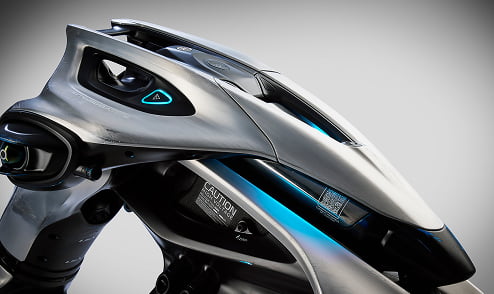

Having gained the ability to control itself through reinforcement learning and Sim2Real, MOTOROiD:Λ stands as a manifestation of the future’s intelligent motorcycles. People will obviously see the machine in different ways. The inspirations they draw from watching the stage demonstrations are sure to vary, too. Some might marvel, “Can AI really control movement this precisely?” Others might think, “It’s still got a ways to go.” But the pace of evolution is astonishing. Developers say that on some days, it’s suddenly able to do things it hadn’t been able to do the day before. The MOTOROiD:Λ you see now could very well move differently tomorrow. And two years from now, at the next Japan Mobility Show, MOTOROiD will be that much further on its evolutionary journey. Everyone who sees it becomes a witness to that growth.
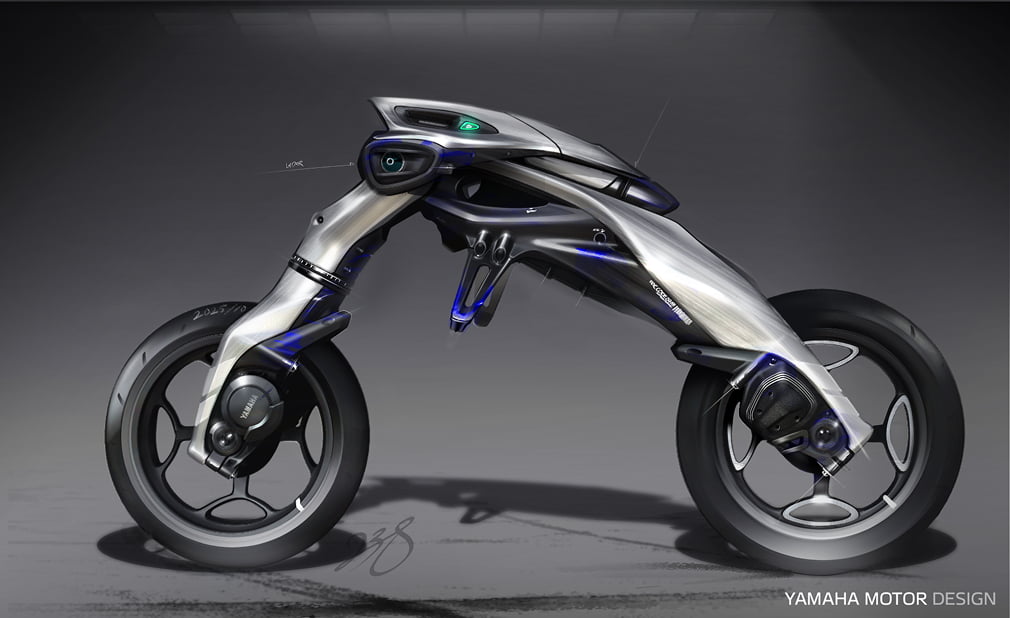
MOTOROiD:Λ ventures into the uncharted field of mobility mixed with reinforcement learning for motion control. It’s an experimental machine that aims to redefine the world of two-wheeled vehicles and pioneer an entirely new future. And out of all the research will emerge technologies and knowledge capable of creating fresh, moving, emotional experiences that stretch beyond what humans alone could ever do.

